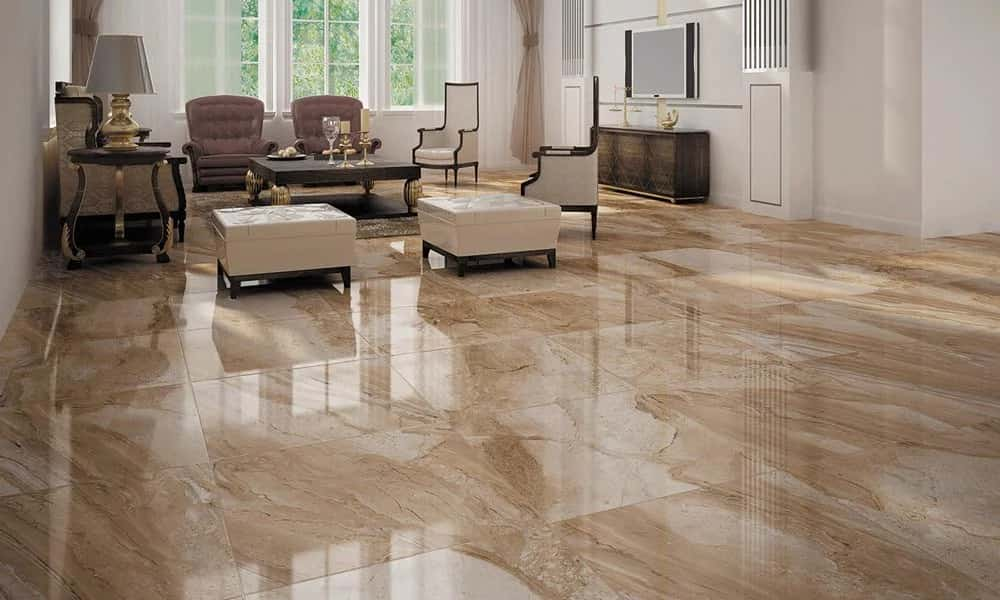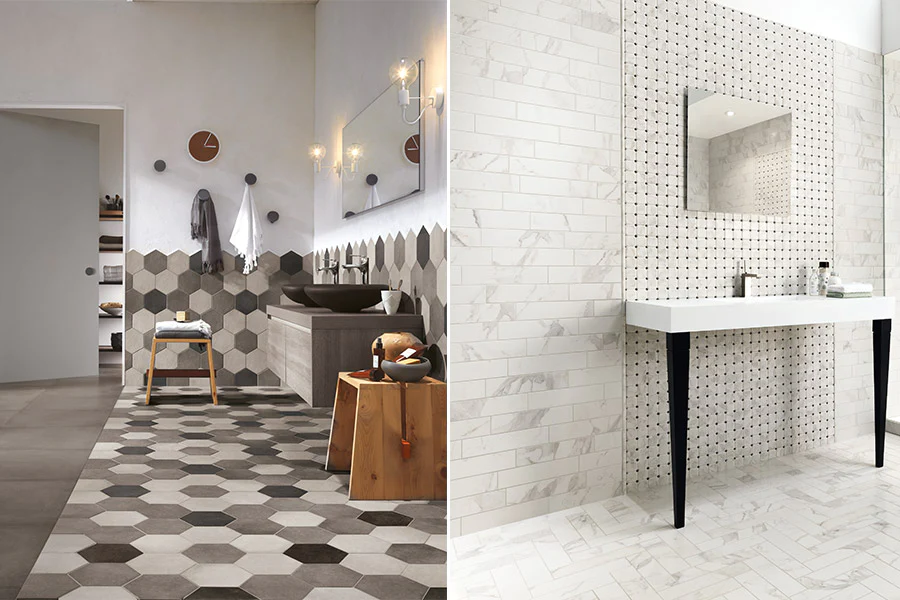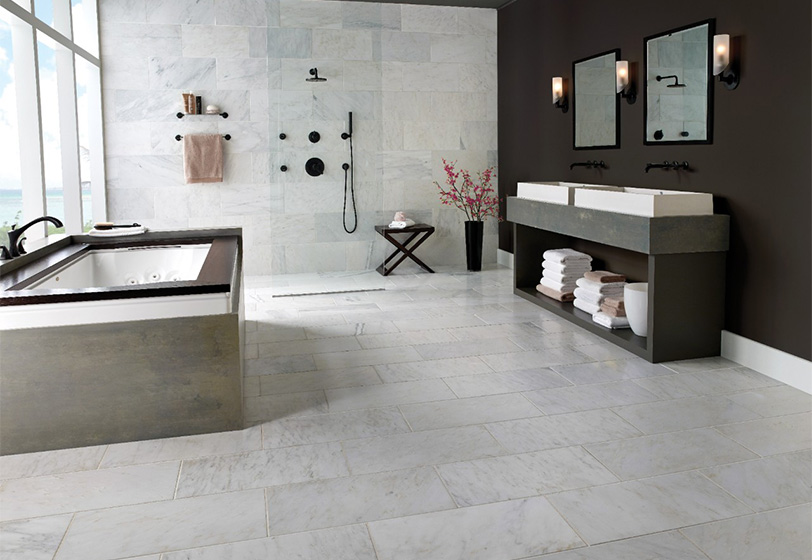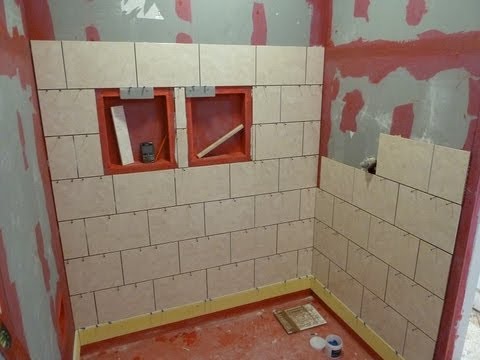Tiling your home and wondering tile floor or walls first? This simple question can stump even seasoned DIYers and professionals alike. Well, you're not alone. We've got you covered with essential insights and practical tips to help guide your decision. Let's dive in and discover the best approach for your tiling project.
Understanding Tiles and Their Applications
In the realm of home improvement and construction, the selection of tiles plays a pivotal role in both the functionality and the aesthetic appeal of a space. When we dissect the differences and applications of floor and wall tiles, we're not just talking about choosing materials. We're delving into an essential aspect of design that affects daily life.


Difference Between Floor Tile and Wall Tile
Tiles, at their core, are more than just pieces of hardened clay or shaped stone; they are the foundation of a room's aesthetic and functionality. When considering the difference between floor tile and wall tile, it's essential to recognize that these differences aren't just superficial—they're built on the distinct needs and stresses each tile must endure.
Wall tile vs floor tile—the comparison is akin to comparing the durability and wear resistance needed for the battleground of the floor versus the less trafficked, but equally important, surfaces of our walls. Floor tiles are the armored warriors of tile, designed to withstand heavy foot traffic, impacts, and the scrapes and scuffs of daily life. Their composition is inherently more robust, often thicker, and equipped with a hardness rating suitable for their battlefield.
Conversely, wall tiles are the artful dodgers, lighter and often thinner, as their primary battles are with splashes and spills rather than boots and shoes. The aesthetic diversity found in wall tiles is vast, allowing for intricate designs and textures that might not withstand the harsher environment of the floor.
This distinction becomes particularly evident when we talk about floor and wall tile in a singular context, such as in bathrooms or kitchens where both types of tiles meet. The floor wall tile transition is not just a functional necessity but an artistic opportunity, allowing designers and homeowners to blend durability with beauty.
You've learned about the differences, but what about the aesthetics?
>> See What is High Gloss Tiles? for insights into choosing the right finish for your project's look and feel.
Can You Use Floor Tiles on Walls?
The question of whether you can use floor tile on walls is one that reflects the versatility of modern tiling. Technically, the answer is a resounding "Yes." Floor tiles can indeed be used on walls, and this practice is often seen in designs seeking a cohesive look or needing the durability of floor tiles in high-impact wall areas.
However, when pondering can you put wall tiles on the floor, caution is the word of the day. The reverse scenario is not as forgiving, primarily because wall tiles are not designed to handle the abrasive forces exerted on floor surfaces. The risk of cracks, chips, and rapid wear is significantly higher, making this a less advised choice.
For those wondering can you use floor tiles on walls, it's essential to consider the weight. Floor tiles are heavier, and not all wall structures are built to support that additional weight. It's always a good idea to consult with a professional to ensure that your wall can bear the load without risking structural integrity.
Considering the weight and structural support for using floor tiles on walls?
Check out Revolutionize Your Tile Installation with Vibrating Suction Cup for Tile - The Ultimate Solution for Perfectly Level Tiles for innovative methods to ensure your tiles are perfectly level and securely attached, no matter where you place them.
The Tiling Process Explained
Embarking on a tiling project, whether it's for a new build or a renovation, involves more than selecting the right tiles. The order in which you install these tiles can significantly affect both the project's timeline and its overall success. Here, we delve into the professional approach to this crucial decision and explore how to seamlessly integrate wall and floor tiles.
Tile Floor First or Walls: The Professional Approach
When faced with the question of whether to tile floor first or walls, professionals often lean towards starting with the floor. This approach isn't just a matter of tradition; it's rooted in practicality. Tiling the floor first provides a solid foundation, allowing for any spillage from wall tiling to fall onto a surface that's already set to be cleaned, rather than ruining newly installed wall tiles.
However, the decision isn't always cut-and-dry. Depending on the specifics of the project, some professionals might opt for tiling walls first. This method can be particularly beneficial in scenarios where the wall design is complex or when ensuring that wall tiles have a precise alignment with the floor tiles is crucial.
Yet, a consensus leans towards starting with the floor for most scenarios, considering the practical benefits and the flexibility it offers for subsequent steps in the tiling process.
Curious about how professionals achieve that seamless look between tile transitions?
>> See Complete Guide: 14 Tile Underlayments You Need to Know to understand the foundation that supports a flawless finish.


Joining Wall Tiles to Floor Tiles
The art of joining wall tiles to floor tiles is a testament to the tiler's skill, bridging the gap between vertical and horizontal planes with precision and aesthetic harmony. This transition is not merely functional; it's an opportunity to enhance the space's visual flow and overall design cohesion.
Successful integration requires careful planning and execution. It often involves selecting complementary tile sizes, colors, and textures that align or contrast beautifully at the juncture. Additionally, the technical aspect — ensuring level and even transitions, accounting for expansion gaps, and selecting the right grout — can make or break the seamless look desired in a well-tiled space.
By considering these approaches and techniques, professionals and DIY enthusiasts alike can navigate the complexities of the tiling process. The choice between tiling the floor or walls first and the method of joining wall tiles to floor tiles underscores the blend of art and science inherent in successful tile installation. Each decision impacts the project's aesthetic outcome and its structural integrity, highlighting the meticulous planning and skilled execution that define professional tiling work.
Mastering the art of joining tiles requires the right tools.
>> Explore The Complete List of Tiling Tools to ensure you have everything you need for a professional-quality job.
Specific Considerations for Different Spaces
Tiling a Shower: Wall or Floor First?
The order in which to tile a shower sparks much debate among professionals. Do you start with the wall, or is the floor the right first step? It's not just a matter of preference; it's about understanding the implications for both waterproofing and the overall integrity of the tiling job.
Starting with the floor might seem logical to ensure that wall tile overlaps the floor tile, creating a more effective barrier against water. Yet, some argue that tiling the walls first allows for cleaner lines and a neater finish, particularly around the base of the wall. This method might be preferred in designs where precision and aesthetics are prioritized over traditional waterproofing concerns.
The decision often comes down to the specifics of the project. For showers with intricate tile work or unusual layouts, tiling the walls first can provide a better visual outcome. However, for most standard showers, beginning with the floor ensures any water that finds its way through will land on a tiled surface, potentially reducing the risk of water damage.


Floor Tile on Wall: Creative Applications
Venturing beyond traditional applications, using floor tiles on walls opens up a new dimension of design possibilities. This approach isn't just about aesthetics; it's also a practical consideration for areas needing durable surfaces that can withstand more than the occasional splash.
Whether it's creating a feature wall that matches the floor for a cohesive look or using textured floor tiles for added depth, this method brings both resilience and style. Yet, it's crucial to ensure the wall can support the weight of floor tiles, which are typically heavier than their wall-mounted counterparts.
Selecting the right tile adhesive and grout is also paramount, as these materials must cope with the additional stress placed on them by the weight of the tiles. It's a balancing act between the visual appeal of using floor tiles on walls and the practical considerations of their installation.
Navigating these decisions requires a blend of design intuition and technical knowledge, striking a balance between how a space looks and how it functions. Whether prioritizing aesthetics or durability, the choices made in tiling a shower or selecting tiles for walls can profoundly impact the feel and functionality of a space.
DIY Tiling Tips and Tricks
Embarking on a DIY tiling project can be a rewarding endeavor, offering a personal touch to your space while also potentially saving on labor costs. However, the process comes with its own set of challenges and decisions, notably, the sequence of tiling and how to ensure a professional-looking finish.
Do You Tile the Floor or Wall First? A DIY Perspective
When diving into a DIY tiling project, one of the first decisions you'll face is whether to tile the floor or wall first. The conventional wisdom suggests tiling the floor first for several practical reasons. This approach allows any drips of adhesive or grout from the wall tiles to fall onto a surface that's already been tiled, making cleanup easier and protecting the newly laid wall tiles.
However, the answer isn't always so straightforward. Should I tile the floor or walls first? This question might lean towards starting with the walls in certain situations, such as when working in tight spaces where tiling the floor first could lead to difficulties moving around without damaging the tiles.
The key is to assess your specific project's needs. Consider the layout of your room, the type of tiles you're using, and how confident you feel about keeping the floor clean if you start with the walls. For many DIYers, tiling the floor first remains the preferred method for its simplicity and practical benefits.
For DIYers looking to tackle transitions and edging with confidence,
>> Visit Step-by-Step Guide to Choosing the Right Flexible Floor Transition Strips.
Should Floor Tile Go Under Wall Tile?
Another consideration is whether floor tile should go under wall tile. This detail might seem small, but it has implications for both the appearance and functionality of your tiling. Typically, allowing the floor tile to go slightly under the wall tile can create a more seamless look and helps with waterproofing, especially in areas like showers or backsplashes.
This method ensures that any water running down the walls will drain onto the tiled floor rather than finding its way behind the tiles, potentially causing damage. So, while it might require a bit more planning and precision, the effort can pay off in the long run with a cleaner finish and improved water resistance.
Maintenance and Care for Your Tiles
After successfully completing your tiling project, maintaining the beauty and integrity of your tiles becomes the next priority. Proper care and maintenance can significantly extend the life of your tiles and keep them looking new for years to come.
Keeping Your Tiles in Top Shape
Tiles, whether on your floor, walls, or both, require regular maintenance to stay in peak condition. For tiles for bathroom walls and floor, this means frequent cleaning to prevent mold and mildew growth, using the right cleaners that won't damage the tile surface or grout.
First flooring and tile care often involves protecting the tiles from scratches and wear, especially in high-traffic areas. Use doormats, rugs, and furniture protectors to minimize direct contact with hard objects or debris that could scratch the surface.
For cleaning, opt for pH-neutral cleaners for both tile wall and floor, avoiding harsh chemicals that can erode grout or dull the tile's finish. In bathrooms and kitchens, paying extra attention to grout lines can prevent grime buildup, keeping the wall & floor looking pristine.
Remember, regular care not only keeps your tiles looking their best but also extends their lifespan, making your DIY project a lasting part of your home's charm. Whether it's how to tile a wall, how to tile walls, or how to tile a shower floor and walls, the key to success lies in both the execution of your project and the ongoing care you provide.
FAQs about Tile Floor or Walls First
When you tile a wall, do you start at the bottom?
Starting with a full tile at the bottom is commonly recommended, but it's essential to consider the overall visual impact. Plan the layout to ensure the top row is not just a thin sliver of tile, which might detract from the aesthetics. Measure and adjust your starting point accordingly, potentially beginning with a cut tile at the bottom to allow for more substantial pieces at both the top and bottom. This approach enhances the visual symmetry and balance, especially in prominent areas.
Do you tile walls before or after fitting a bathroom?
For a seamless and professional finish, it's advisable to tile the walls before installing bathroom fixtures like the sink, shower, bathtub, and toilet. This allows the fixtures to sit neatly on top of the tiles, ensuring better waterproofing and a cleaner look. Tiling first also provides flexibility for future updates or changes to your bathroom fixtures without disturbing the tile work.
Do you tile before or after plumbing?
Plumbing installations should precede tiling, particularly in areas like the tub or shower. Once plumbing fixtures and connections are securely in place, tiling can commence, starting from the tub or shower area and moving outward. This sequence ensures that tiles can be precisely cut and fitted around plumbing fixtures, maintaining water tightness and achieving a polished finish.
Do you install vanity before tile?
Tiling the entire room before installing the vanity offers the most flexibility for future renovations and ensures a uniform tile layout beneath the vanity. This approach not only prepares the space for any potential changes in bathroom fixtures but also provides a comprehensive, finished look regardless of the vanity size or style changes over time.
Does bathroom vanity go on top of tile?
If you're committed to your current vanity and don't anticipate changing it, tiling around it is a viable option. This method is practical for fixed installations where the vanity's position and style will remain unchanged, simplifying the tiling process while still allowing for a cohesive room design. However, fully tiling the floor offers maximum versatility for future updates.
Should toilet sit on top of tile?
Installing the toilet flange directly on top of the finished tile floor is crucial for creating a secure and leak-proof base. This placement ensures the flange is at the optimal height for connecting the toilet, preventing potential leaks by eliminating gaps between the toilet base and the floor. Proper flange installation on the tile surface is key to a successful and durable toilet installation.


